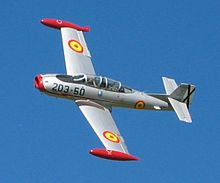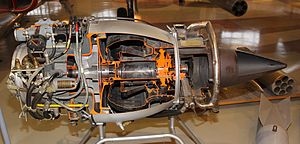Turbomeca Marboré: Difference between revisions
Typo fixing, combine duplicate sections, switch to asterisk as screen readers don't work well with those "pseudo-heading" semi-colons, typo(s) fixed: As a result → As a result, using AWB |
Rescuing 1 sources and tagging 0 as dead. #IABot (v1.6.2) (Balon Greyjoy) |
||
| Line 105: | Line 105: | ||
==External links== |
==External links== |
||
{{Commons category}} |
{{Commons category}} |
||
* [http://www.freewebs.com/iconicj/ Iconic's Marbore IIC] |
* [https://web.archive.org/web/20071107063654/http://www.freewebs.com/iconicj/ Iconic's Marbore IIC] |
||
* [http://www.minijets.org/typo3/index.php?id=83 Aircraft fitted with MARBORE II or VI] |
* [http://www.minijets.org/typo3/index.php?id=83 Aircraft fitted with MARBORE II or VI] |
||
*[http://www.minijets.org/index.php?id=129 minijets website Marboré I] |
*[http://www.minijets.org/index.php?id=129 minijets website Marboré I] |
||
Revision as of 05:38, 26 January 2018
| Marboré | |
|---|---|

| |
| Marboré II on display at the Museum für Luftfahrt und Technik | |
| Type | Turbojet |
| National origin | France |
| Manufacturer | Turbomeca |
| First run | 16 June 1951 (first flight) |
| Major applications | Fouga Magister Fouga Zéphyr |
| Variants | Teledyne CAE J69 |
The Turbomeca Marboré was a small turbojet engine produced by Turbomeca from the 1950s into the 1970s. The most popular uses of this engine were in the Fouga Magister and the Morane-Saulnier MS-760. It was also licensed for production in the United States as the Teledyne CAE J69,.[1]
Variants
The first major production version was the Marboré II, which had a maximum thrust of 3.9 kN (880 lbf) at 22,500 rpm. In its most basic form, it is a single-spool, centrifugal compressor turbojet. Fuel consumption was rated at 410 L/h (90 imp gal/h; 110 gal/h). Variations include military or civilian aircraft, oil tank design, auxiliary equipment, and exhaust pipe configuration. Some variants also included one axial stage compressor for additional performance. The engine dimensions of different variants with different auxiliary components and mounting configurations.
These were eventually replaced by the Marboré VI series which were slightly more powerful at was 4.8 kN (1,100 lbf) instead of3.9 kN (880 lbf). Fuel consumption was only slightly higher at 450 L/h (99 imp gal/h; 120 gal/h). This was a 23% increase in thrust with slightly more than a 9% increase in fuel consumption. As a result, the IV series were used to re-engine many II-series aircraft, and Marboré II engines are still available cheaply as surplus for the experimenter.
The original Marboré, as well as Marboré III, IV, and V were not produced in significant numbers.
A typical weight for this series of engines is 140 kg (310 lb).
Fuel consumption is 720 L/h (160 imp gal/h; 190 gal/h) on the Marboré VI at 4,500 m (14,800 ft), as compared to 520 L/h (110 imp gal/h; 140 gal/h) on Marboré II engines (same altitude). An increase of 27% fuel consumption and a decrease in cruise range capabilities.[2]
- Marboré I:
- Marboré II:
- Marboré IIC:
- Marboré III:
- Marboré IV:
- Marboré V:
- Marboré VI:
- Teledyne CAE J69:Licence production and development in the United States.
Applications

- Marboré
- Ambrosini Sagittario
- Bölkow Bo 46
- Fouga Magister
- Fouga Zéphyr
- Hispano HA-200
- Morane-Saulnier MS.755 Fleuret
- Morane-Saulnier MS.760 Paris
- Nord Aviation CT20
- ONDERA Deltaviex
- SNCASO Trident
- Stargate YT-33
- J69
- See Teledyne CAE J69
Specifications (Marboré IIC)

Data from FAA TCDS[3]
General characteristics
- Type: Turbojet
- Length: 156.7 cm (61.7 in)
- Diameter: 63.2 cm (24.9 in)
- Dry weight: 162.4 kg (358 lb)
Components
- Compressor: Single stage centrifugal
- Combustors: Single annular combustion chamber
- Turbine: Single stage
- Fuel type: Aviation kerosene Air 3405 (JP-1)
Performance
- Maximum thrust: 3.91 kN (880 lbf ) at 22,600 rpm
- Turbine inlet temperature: 650 °C
- Thrust-to-weight ratio: 0.024 kN/kg (2.458 lbf/lb)
See also
Related development
Related lists
References
- ^ Gunston 1989, p.169.
- ^ CM-170 Flight Tests, Airplane Cruise Performance Charts, and Aircraft Flight Manuals
- ^ FAA Type Certificate Data Sheet Retrieved: 2 November 2008
- Gunston, Bill. World Encyclopedia of Aero Engines. Cambridge, England. Patrick Stephens Limited, 1989. ISBN 1-85260-163-9